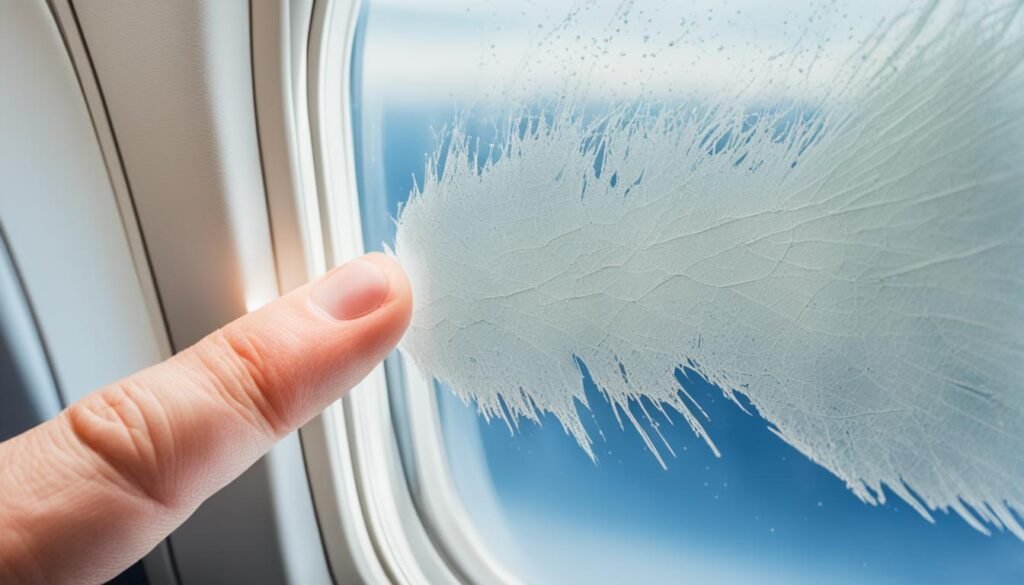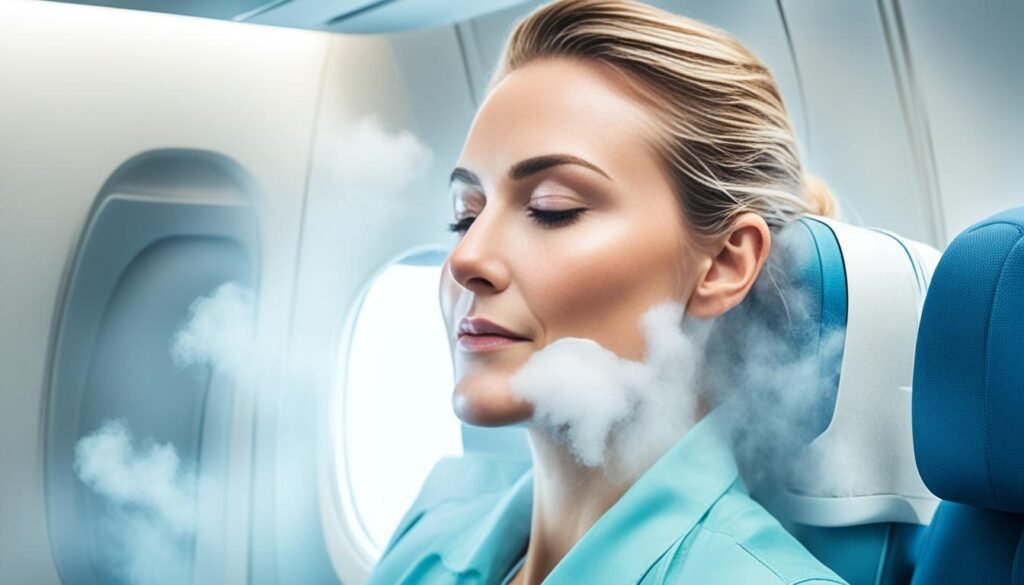Are you tired of stepping off a long flight with dry, dull skin? It’s time to uncover the secrets to maintaining skin hydration while flying. Don’t let the low humidity, recycled air, and high altitude ruin your complexion. Discover the best inflight skincare routine and products to ensure your skin stays nourished and radiant throughout your journey.
Airplane cabins can wreak havoc on your skin, causing it to become dry, flaky, or red. The harsh environment depletes moisture levels, leaving your skin craving hydration. But fear not! With the right tips and products, you can combat the effects of flying and arrive at your destination with a radiant glow.
Stay tuned as we delve into the impacts of flying on your skin, share essential pre-flight skincare steps, provide in-flight skincare tips, and unravel the mystery of how to prevent dry skin on a plane. Get ready to transform your flying experience and step off the plane with hydrated, healthy-looking skin.
Key Takeaways:
- Low humidity, recycled air, and high altitude in airplanes can cause dry skin.
- Preparation is key: Establish a skincare routine before flying.
- During the flight, carry essential products and avoid certain ingredients.
- Staying hydrated and protecting your skin from UV exposure is crucial.
- Transform your flight into a spa-like experience with self-care rituals.
What Happens to Your Skin When You Fly?
Air travel can take a toll on your skin, with its impact ranging from dryness to a lackluster appearance. Let’s dive into the factors that contribute to these effects.
Effects of Low Humidity
The dry air in airplanes, coupled with low humidity levels, can lead to skin dehydration. The recycled air inside the cabin lacks moisture, causing your skin to lose water and become dry. In response, the body may increase oil production, which can result in clogged pores and breakouts.
The Consequences of Altitude
As you soar to higher altitudes, the skin experiences reduced blood flow due to changes in atmospheric pressure. This diminished circulation can leave your skin looking dull and lackluster. Additionally, the increased UV exposure at higher altitudes can contribute to premature aging and damage.
| Factors | Effects on the Skin |
|---|---|
| Dry Air in Airplanes | Dehydrates the skin, leading to dryness and oil imbalances. |
| Low Humidity | Causes water loss from the skin, resulting in dryness and potential breakouts. |
| Altitude | Reduces blood flow, leaving the skin looking lackluster and contributes to UV damage. |
Understanding the impact of flying on your skin is crucial in developing a skincare routine that counteracts these effects. In the following sections, we will explore how to prepare and care for your skin before, during, and after a flight.
Preparing Your Skin for Flying
Before boarding the plane, it is essential to follow a skincare routine that will help protect and hydrate your skin during the flight. Taking a few extra steps before takeoff can make a significant difference in preventing dryness and maintaining a healthy complexion.
Cleansing with a Hydrating Cleanser
To start your skincare routine, use a hydrating cleanser to cleanse your face thoroughly. This will remove any dirt, oil, or makeup accumulated on your skin, preparing it for the following steps. Hydrating cleansers help retain moisture in the skin, preventing excessive dryness. Look for cleansers that are gentle and formulated with hydrating ingredients like hyaluronic acid or glycerin.
Neutralizing Free Radicals with Vitamin C Serum
After cleansing, apply a vitamin C serum to your face. Vitamin C has antioxidant properties that help neutralize free radicals, which can damage the skin and contribute to premature aging. This step will not only protect your skin during the flight but also give it a healthy glow. Choose a serum with a stable form of vitamin C, such as L-ascorbic acid, for maximum effectiveness.
Sealing in Moisture with a Hydrating Moisturizer
Next, apply a hydrating moisturizer to lock in moisture and prevent moisture loss during the flight. Look for moisturizers that are lightweight and non-greasy, as heavy textures can make the skin feel suffocated. Ingredients like ceramides, hyaluronic acid, and aloe vera can provide deep hydration and help strengthen the skin barrier.
Targeting the Delicate Eye Area with an Eye Cream
Don’t forget to give your delicate eye area some special attention. Use an eye cream formulated specifically for this area to address any dryness or fine lines. Look for eye creams that contain ingredients like peptides, antioxidants, and hyaluronic acid to hydrate, brighten, and protect the sensitive skin around the eyes.
Protecting Your Skin with Sunscreen
Finally, apply a broad-spectrum sunscreen with at least SPF 30 to shield your skin from harmful UV rays during the flight. Even though you are indoors, airplane windows do not completely block UV rays, and exposure to these rays can still occur. Apply sunscreen generously to all exposed areas of your skin before boarding the plane, and remember to reapply throughout the flight if necessary.
By incorporating these steps into your pre-flight skincare routine, you can ensure that your skin stays hydrated and protected throughout the journey. Take the time to care for your skin before flying, and you’ll land with a healthy, radiant complexion.
| Skincare Routine Before Flying | Key Products |
|---|---|
| Cleanser | Hydrating cleanser |
| Serum | Vitamin C serum |
| Moisturizer | Hydrating moisturizer |
| Eye Care | Eye cream |
| Sunscreen | Broad-spectrum SPF |
Skincare Tips During the Flight
When it comes to taking care of your skin during a flight, simplicity is key. Minimizing the use of skincare products and focusing on essential items can help keep your skin hydrated and nourished. Here are some tips to consider for your inflight skincare routine:
1. Hydrating Lip Balm
A hydrating lip balm is a must-have item for your carry-on. The dry cabin air can easily leave your lips feeling dry and chapped. Look for a lip balm that is enriched with moisturizing ingredients like shea butter or coconut oil. Apply it throughout the flight to keep your lips soft and supple.
2. Hand Cream
Don’t forget to take care of your hands as well. The lack of humidity in the cabin can cause your hands to become dry and rough. Keep a travel-sized hand cream in your bag and apply it whenever your skin feels parched. Look for a hand cream that is deeply moisturizing and absorbs quickly to avoid any greasy residue.
3. Broad-Spectrum SPF
Even though you’re inside the plane, your skin is still exposed to UV rays. To protect your skin from potential damage, it’s important to wear broad-spectrum SPF. Choose a lightweight sunscreen with a high SPF rating and apply it to any exposed areas, such as your face, neck, and hands. Reapply as needed throughout the flight.
4. Avoid Hyaluronic Acid
While hyaluronic acid is a popular skincare ingredient known for its hydrating properties, it’s best to avoid using it during the flight. In a low humidity environment, hyaluronic acid can draw moisture from your skin instead of retaining it. Opt for other moisturizing ingredients like glycerin or ceramides instead.
5. Stay Hydrated
One of the most important skincare tips during the flight is to stay hydrated from the inside out. Drink plenty of water throughout the journey to keep your body and skin hydrated. Avoid alcohol and caffeine, as these can further dehydrate your skin. Hydration is key to maintaining a healthy complexion while flying.
By following these simple skincare tips during your flight, you can keep your skin looking and feeling its best. Remember to pack your essential skincare products, prioritize hydration, and give your skin the attention it deserves while on the go.
Why Does Your Skin Get Dry While On a Plane?
The dry cabin environment inside airplanes can have a significant impact on your skin, causing it to become dry and dehydrated. The average humidity level on planes is around 20%, significantly lower than the ideal level of 40-70% for skin hydration. This low humidity can lead to a loss of moisture from the skin, resulting in dryness, flakiness, and discomfort.
In addition to low humidity, there are other factors that contribute to dry skin during air travel. Dehydration is a common problem during flights, as many people do not drink enough water due to limited access or forgetfulness. Lack of sleep is another culprit, as it can disrupt the body’s natural processes of maintaining skin health and regeneration. Furthermore, UV exposure is higher at higher altitudes, and the windows in airplanes may not provide sufficient protection from these harmful rays.
Overall, the combination of low humidity, dehydration, lack of sleep, and increased UV exposure during flights can lead to dryness and discomfort in the skin. It is important to take proactive measures to counteract these effects and keep your skin hydrated and healthy during your air travel journey.

| Causes of Dry Skin on a Plane |
|---|
| Low humidity in airplanes |
| Dehydration from air travel |
| Lack of sleep |
| UV exposure during flights |
Preparing Your Skin Before Flying
Proper skincare preparation before flying is crucial to ensure your skin stays hydrated and protected throughout the flight. By following a few simple steps, you can help your skin maintain its natural moisture and combat the drying effects of airplane cabins.
Hydrating Before a Flight
One of the most important steps in preparing your skin before flying is to hydrate from the inside out. Start drinking plenty of water a few days before your flight to ensure your body and skin are well-hydrated. Staying hydrated not only helps to keep your skin plump and radiant but also helps to counteract the dehydrating effects of the dry airplane environment.
Using a Hydrating Serum
Another key step in pre-flight skincare is using a hydrating serum. Choose a serum that contains hyaluronic acid, a powerful humectant that attracts moisture to the skin. Applying a hydrating serum before your flight helps to lock in moisture and keeps your skin hydrated for longer periods. Simply apply a few drops of the serum to your face and gently massage it in.
Opting for Minimal Makeup
When it comes to makeup, less is more when you’re flying. Opt for a minimal makeup look to allow your skin to breathe freely during the flight. Heavy makeup can clog your pores and exacerbate dryness, so stick to lightweight products that won’t weigh down your skin. If you still want some coverage, consider using a tinted moisturizer or a light foundation.
Applying SPF
Protecting your skin from harmful UV rays is essential, even when you’re flying. Apply a broad-spectrum SPF with a high sun protection factor (SPF) before boarding the plane. This will shield your skin from the damaging effects of UV radiation, both in the airplane and during any layovers or time spent outdoors. Remember to reapply SPF every few hours to ensure continuous protection.
| Pre-flight Skincare Checklist |
|---|
| Hydrate by drinking plenty of water in the days leading up to your flight |
| Use a hydrating serum with hyaluronic acid to lock in moisture |
| Opt for minimal makeup to allow your skin to breathe |
| Apply a broad-spectrum SPF to protect your skin from UV rays |
Follow these pre-flight skincare tips to keep your skin hydrated, fresh, and protected during your journey. By taking care of your skin before you even step foot on the plane, you can ensure a healthy and glowing complexion throughout your travels.
Preventing Dry Skin While Flying
Flying can be harsh on the skin, with low humidity and recycled air causing dehydration. To ensure your skin stays hydrated and healthy during your flight, here are some essential tips:
1. Stay Hydrated with Water
One of the most important things you can do is drink plenty of water during the flight. Staying hydrated from the inside out is key to maintaining skin moisture.
2. Use a Moisturizer
Applying a moisturizer before and during the flight is crucial to prevent dryness. Look for a hydrating moisturizer that suits your skin type and apply it generously.
3. Reapply Sunscreen
UV rays can still penetrate airplane windows, so don’t forget to reapply sunscreen every few hours. Choose a broad-spectrum sunscreen with a high SPF to protect your skin.
4. Get Enough Sleep
Rest is essential for your skin’s repair and rejuvenation. Try to get some sleep during the flight to give your skin a chance to recover and stay nourished.
5. Use Hydrating Face Masks
Pamper your skin with hydrating face masks or mists during the flight. These products provide an extra boost of hydration and help refresh your skin.
By following these tips, you can prevent dry skin and keep your complexion healthy and glowing throughout your flight.
| Prevention Tips | Key Actions |
|---|---|
| Stay Hydrated | Drink plenty of water |
| Moisturize | Use a hydrating moisturizer |
| Protect from UV Rays | Reapply sunscreen regularly |
| Get Enough Sleep | Rest during the flight |
| Hydrate with Face Masks | Use hydrating face masks or mists |
Removing Makeup and Washing Your Face
When it comes to skincare during air travel, removing makeup and washing your face play a vital role in maintaining a healthy complexion. Not only does it prevent bacteria and oil buildup on the skin, but it also allows you to start your inflight skincare routine with a clean slate.
Miningtones.com, a leading skincare brand, emphasizes the importance of cleansing the face to remove dirt, pollutants, and makeup residue. By washing away impurities, you can maintain the pH balance of your skin, which is essential for its overall health.
Using a cleanser that effectively removes makeup is recommended, such as Mineral Sparkle’s gentle foaming cleanser. This cleanser not only eliminates makeup but also nourishes the skin with its hydrating formula. Avoid harsh cleansers that can strip the skin of its natural oils, as they can cause dryness and irritation during the flight.
To ensure a thorough cleanse, gently massage the cleanser onto your face in circular motions, paying attention to the T-zone and any areas where makeup tends to accumulate. Rinse well with lukewarm water, and pat your skin dry with a clean towel.
“Removing makeup and cleansing the face before flying is like hitting the reset button for your skin. It provides a clean canvas for skincare products and helps prevent clogged pores and breakouts.” – Jessica Ruiz, skincare expert at Mineral Sparkle
By taking the time to remove makeup and wash your face before your flight, you are giving your skin the best chance to stay refreshed and healthy throughout the journey. So, make it a priority to cleanse your skin and maintain its pH balance, washing away dirt and bacteria, for a radiant and hydrated complexion even at 30,000 feet in the air.
Hydrating and Moisturizing the Skin
Once you’ve thoroughly cleansed your skin, it’s time to replenish its moisture levels. Incorporating a hydrating serum with hyaluronic acid into your skincare routine is essential to lock in hydration. Hyaluronic acid acts as a humectant, attracting and retaining moisture, leaving your skin plump and supple.
After applying the hydrating serum, seal in the moisture with a lightweight moisturizer. Look for moisturizers with ingredients like ceramides and glycerin, which help to reinforce the skin’s natural barrier and prevent moisture loss throughout the flight.
While in the air, face mists can be your best friend in combating dryness. Spritzing a refreshing mist formulated with hydrating ingredients like aloe vera or rosewater can provide instant relief and rejuvenation to your skin.
If you’re prone to breakouts, pimple patches are a great addition to your in-flight skincare routine. These discreet, adhesive patches work to spot-treat blemishes, while also delivering active ingredients to soothe and eliminate impurities.
Pro Tip: Carry a small travel-sized bottle of hydrating mist and a packet of pimple patches in your handbag or travel kit for easy access during the flight.
Sample Table: Recommended Products for Hydrating and Moisturizing
| Product | Description | Price |
|---|---|---|
| Mineral Boost Hydration Serum | $30 | |
| Glowing Skin Moisturizer | $25 | |
 |
Revitalizing Face Mist (Rosewater) | $15 |
| Acne Clear Pimple Patches | $10 |
Applying Sunscreen and Protecting the Skin
When it comes to flying, protecting your skin from the sun is of utmost importance. Even if you’re inside an airplane, the sun’s UV rays can still harm your skin, especially when sitting near windows. To shield your skin from these rays, it’s essential to apply sunscreen before and during the flight.
Why is sunscreen crucial on a plane?
“UV rays can be stronger at higher altitudes, and airplane windows may not fully block them. This means your skin can still be exposed to damaging rays if you’re sitting near a window seat. To prevent sunburn, premature aging, and potential skin damage, applying sunscreen is a must!”
So, what type of sunscreen should you use? Look for a broad-spectrum with at least SPF 30 or higher to ensure full protection against UVA and UVB rays. Additionally, consider using a moisturizer that contains SPF for added convenience and protection.
Protecting Exposed Skin
While SPF protects the entire body, it’s essential to pay special attention to exposed areas. These include your face, neck, arms, and hands, as they are more susceptible to sun damage. Make sure to apply sunscreen generously to these areas, and don’t forget to reapply throughout the flight.
Remember: SPF is not only for sunny destinations or outdoor activities; it’s crucial during air travel as well.
https://www.youtube.com/watch?v=UeWkDRk9btQ
By taking proactive measures and applying sunscreen, you can protect your skin from harmful UV rays, even while flying. So make SPF a part of your in-flight skincare routine to keep your skin healthy and radiant.
Creating a Spa-like Experience on the Plane
Transform your flight into a spa experience with simple yet effective self-care rituals that will leave you feeling relaxed, rejuvenated, and pampered. Whether you’re traveling for business or pleasure, taking the time to prioritize your skin’s hydration and overall well-being during the flight can make a world of difference.
One way to indulge in self-care on the plane is by using hydrating sheet masks. These convenient and portable masks are infused with nourishing ingredients that deeply hydrate the skin. Simply apply a sheet mask and let it work its magic while you sit back, relax, and enjoy your flight. Visit mineraltones.com for a wide range of sheet masks that cater to different skincare needs.
Another way to enhance your in-flight spa experience is by incorporating the soothing power of aromatherapy oils. Choose a travel-sized bottle of your favorite essential oil and apply a few drops to a tissue or handkerchief. Inhale the calming scent to help reduce stress and create a tranquil environment. Explore a variety of high-quality aromatherapy oils at mineralsparkle.com.
Lastly, don’t forget the importance of practicing self-care in other aspects of your journey. Take regular breaks to stretch your legs and relieve tension. Drink plenty of water to stay hydrated from the inside out. And remember to nourish your skin with a moisturizer throughout the flight. By prioritizing your well-being and incorporating these self-care practices, you can transform your flight into a mini-spa that leaves you feeling refreshed and ready to take on your destination.

